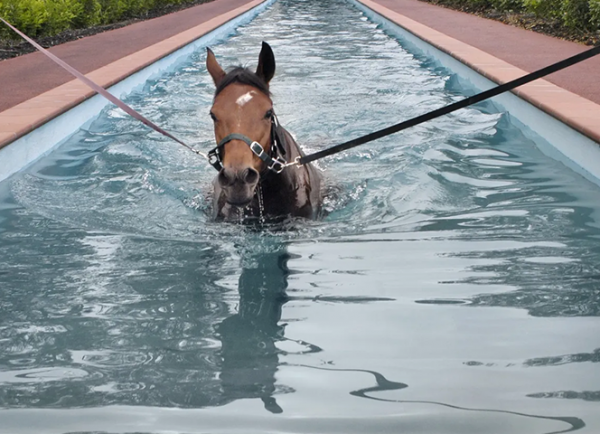
Reduce the risk of an injury massively and increase the well-being of your polo ponies !
Regular swimming in a horse pool is much more than only treating your horse You are enthusiastic about polo. You appreciate the sporty fights on the field and social with each other afterwards. Have you ever wondered what you could do for the well-being of your polo ponies besides regular training, good feeding, a clean stable and grazing? Today we have the perfect tip for you: Regular swim training!

Veterinary clinics offer swimming for horses during rehabilitation, and swimming has been shown to reduce the recovery time after injuries massively. In the following article, however, we will focus on showing what regular swimming can do for polo ponies, who are required to perform at high levels every day in training and tournaments.
And we would also like to find out from our expert Liz Newman (founder and CEO of Horse Homes – www.horse-homes.com) how she goes about planning horse pools, for whom such a pool is suitable and what costs are to be expected.
Liz, let us first work out the advantages that regular use of a pool offers for owners of polo horses. Does swimming only serve to protect muscles and tendons, or can it also be used to improve fitness and how exactly does the therapy affect the horse’s body?
Incorporating swimming into all your horses’ general training program will greatly assist in preventing injuries and improving performance. A top polo pony needs to be fast, powerful, and have plenty of stamina. They also need to move with a lot of dexterity, agility and manoeuvrability. Ponies need to gallop fast, stop quickly and spin a 180-degree rollback. Well-developed hindquarters and well-muscled gaskins are vital for performance and injury prevention. A horse that swims as part of his exercise regime will gain muscle strength and superior cardiovascular fitness quicker than a horse trained exclusively on the ground.
Swimming has been proven to increase the contractility of the heart, meaning that the heart is able to contract and relax more efficiently. By increasing the efficiency of the heart, you are increasing systemic circulation. When the heart is being exercised by cardio workouts such as swimming, the lungs are required to take in more oxygen. This is achieved by increasing the rate of respiration. When systemic circulation improves, so does oxygen supply to the tissues. Swimming allows the horse to build a strong heart and lungs, without the upward concussive forces applied to soft tissues, bones and joints while exercising in the traditional manner.
What does the training plan look like when the focus is on injury prevention?
Getting your horses as fit as possible, without injuring them during the process is the key. The vast majority of injuries happen when horses are asked to work above their personal level of fitness. Swimming works in tandem with ridden work, it does not replace it. Weight-bearing exercise is required to strengthen bone, swimming builds soft tissue strength. It also has a tremendous effect on cardiovascular fitness. By increasing your horse’s fitness using the combination of ridden and swimming work you will get your horse fitter quicker and free of injuries.
How should I imagine muscle building training for a polo horse?
Start slowly with both ridden work and swimming and increase both in parallel. As fitness increases, step up the swimming time and keep fast ridden work at an acceptable level. Recent research shows that a horse swimming for 5 – 8 minutes can increase a horse’s heart rate from 34 to 175 beats per minute. This is close to the 200 beats per minute experienced by a horse breezing over 1 mile (or 1.6km) on the track. Swimming a horse for 15 minutes is the same as galloping a horse, unencumbered by a rider, for 5 miles (or 8 km), from a conditioning perspective.
Horses can naturally swim, but swimming pools are unfamiliar to horses. How do you get a horse to walk into the water ?
Most horses, even those swimming for the first time, are happy to enter a pool as long as the handlers are confident and experienced. A very small percentage who are reluctant are usually fine if they follow an experienced horse into the pool.
If you are planning a horse pool, how do you go about it? Are there special parameters that you have to consider?
When designing a new pool, we initially look at the climate at the site location. In areas with cold winters and below zero temperatures we must also plan a building to house the pool. In locations with mild weather throughout the year, we are able to build the pool outside. It is important that we carry out a site survey with our pool engineer so that we understand the type of terrain and the services available like drainage. Once we understand the possible design options for the location, we meet with our client and architect to understand their requirements. All our pools are unique designs with many optional features that can be added depending on the client’s style choice

There are basically two different variants to choose from for building or setting up a swimming pool or pool for horses. There are straight swimming pools, round pools for horses and a combination of both. What kind of pool do you prefer and why?
When equine pools were first conceived they were mostly round. Many are still in use today. I am not a fan of round pools and I always recommend a straight pool to new clients. From a training perspective, a straight pool is far safer for horses and handlers. In a round pool horses tend to build muscle unevenly which makes the horse more prone to injuries. In a straight pool it is far easier to monitor heart and respiratory rate and horses find they are able to quickly develop their swimming technique and increase their level of fitness faster. What construction costs should a polo club expect when considering the purchase of a horse swimming pool? The basic cost of a straight 45m pool is around € 200,000 constructed on a relatively accessible and level site with access to drainage, water and power supplies nearby.
Building a horse pool is very different from building a people pool and consequently more costly. The monthly upkeep varies tremendously depending on how many horses use the pool, staffing levels and climate. However, for polo clubs, building a horse pool can be a game-changer for attracting new clients. For example, in form of cooperation with trainers of racehorses or with animal clinics in the area, who book appointments of the pool for their rehabilitation horses.
From what number of horses does a horse pool pay for itself for an operator?
Most commercial pools charge around €30 to €40 – per horse, per swimming session, regardless of how many lengths the horse swims. If they swim 20 horses a day @ € 30.- they would cover their capital outlay within 1 year.
How much space is necessary for the construction of a horse pool?
Our most popular pools are be – tween 40 – 45m long by 3.5 or 4m wide. We can build shorter pools but this does not reduce construction costs by very much. Ideally, the apron surrounding the pool should be at least 10 – 15m wide.
In addition to swimming pools for horses, there are also special Equine spas (whirlpools). In your opinion, is the Equine spas an alternative to a “normal” horse swimming pool, or just a supplement and why?
Equine spas are excellent, but they do a completely different job to an equine pool. The saltwater in the spa is very cold and is good for reducing swelling in legs, improving horn growth and speeding up the healing of wounds, therefore they are purely a therapeutic aid. Equine pools are for fitness training, injury prevention and injury rehabilitation.
First published here, this interview was conducted between Liz Newman, Founder and CEO of Horse Homes, and Polo & Luxury. You can also view this article on EquineShow247





